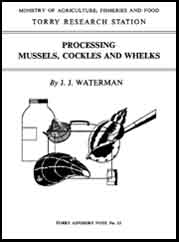Contents Index

Accompanying Notes
Table of Contents
MINISTRY OF AGRICULTURE, FISHERIES AND FOOD
TORRY RESEARCH STATION
By J. J. WATERMAN
TORRY ADVISORY NOTE No. 13
Crown copyright material is reproduced with the permission of the Controller of Her Majesty's Stationery Office.
This electronic document has been scanned using optical character recognition (OCR) software and careful manual recorrection. Even if the quality of digitalisation is high, the FAO declines all responsibility for any discrepancies that may exist between the present document and its original printed version.
Advises on cooking and extraction of meats from mussels and on the freezing, cold storage, smoking, canning and bottling of the meats. Similar advice is given on the processing of cockles and whelks. Measurements are given in British units; Note 40 gives conversion factors to SI units.
In 1998, landings of mussels, cockles and whelks in the UK were 12,600, 12,000 and 3,500 tonnes respectively. The total value of these species was £8.8 million. About 10,700 tonnes of mussels were farmed. Shell can be used for making chicken grit. Shell can be deposited at sea to encourage the settlement of spat, but it is essential that any disposal at sea complies with local bye-laws and with fish health regulations. Disposal onshore must be licensed. The risks of food poisoning are primarily from sewage contamination of harvesting areas and the unpredictable occurrence of toxin producing microalgae. As filter-feeders, the bivalves can accumulate pathogenic and other bacteria as well as viruses from sewage contamination, and can accumulate potent toxins from toxic microalgae present among the phytoplankton on which the bivalves feed. Illnesses such as gastro-enteritis and hepatitis can result from sewage contamination. Briefly, regulations require that bivalve molluscs for human consumption can only be obtained from the areas officially classified for growing or harvesting. Regulations also require compliance with the expressed limits for bacteria, toxins and contaminants and producers are expected to meet end-product standards. The category of contamination, or classification, officially assigned to the harvesting or growing area determines whether the bivalves can be marketed directly or, before marketing, must be purified, or relayed in a designated area for a required period to purge them of bacteria, or subjected to an approved heat process in approved premises. It is important to note that heat processing may be needed simply to produce a cooked product from molluscs that are already safe to eat or it may be an approved treatment required to ensure that microbiologically contaminated molluscs are rendered safe to eat; different regulations cover these two situations. Briefly, the approved heat processes to inhibit the development of pathogenic microorganisms in both bivalve molluscs and marine gastropods are:
Further guidance may be found in a publication of the Sea Fish Industry Authority (1997), 'Guidelines for the Facilities and Equipment Required for Handling Bivalve Molluscs from Harvesting through to Distribution to Retail Outlets', available from the SFIA, Edinburgh, EH7 4HG, UK. Full details of cleansing procedures and approvals, and shellfish hygiene classifications of growing waters, can be obtained from CEFAS Weymouth, Barrack Road, Weymouth, Dorset, DT4 8UB, or from Fisheries Research Services, Victoria Road, Aberdeen, AB11 9DB. Different algal toxins can cause paralytic shellfish poisoning (PSP), diarrhoetic shellfish poisoning (DSP) or amnesic shellfish poisoning (ASP). Monitoring of shellfish harvesting areas is required for the occurrence of toxic phytoplankton, shellfish flesh is monitored for the presence of toxins and producers are expected to meet end-product standards. Areas are closed when the toxins exceed the prescribed limits and closures are frequent. These comprehensive monitoring programmes are intended to prevent large quantities of contaminated shellfish from reaching the market. Sometimes the red whelk (Neptunea antiqua) can be mistaken for the edible whelk (Buccinum undatum). Although similar in shape, red whelks are usually larger, and the shell is pale yellow/orange and smooth with no ribs in contrast to the characteristic ribs and ridges of the rough shell of the edible whelk. If eaten by mistake, the metabolite tetramine in the salivary gland of the red whelk can cause unpleasant red whelk poisoning. Harvesting from areas in which the red whelk occurs should be avoided, and care should be taken to exclude bait and dead whelks from the harvested whelks. Since whelks spoil rapidly at ambient temperature they should be chilled rapidly after capture. Producers are expected to meet the end-product standards.
(FAO in partnership with Support unit for International Fisheries and Aquatic Research, SIFAR, 2001).
Introduction
Fresh Mussels
Extracting the Meats
Freezing and Cold Storage of Mussels
Bottled Mussels
Jellied Mussels
Smoked Mussels
Canned Mussels
Introduction
Fresh Cockles
Frozen Cockles
Cockles in Brine
Cockles in Vinegar
Canned Cockles
Introduction
Fresh Whelks
Frozen Whelks
Smoked Whelks
Whelks in Vinegar
Canned Whelks
Whelks for Bait
Contents Index